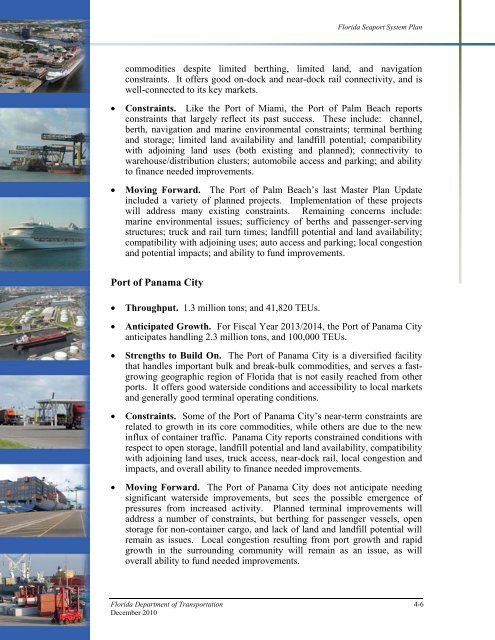Florida Seaport System Plan - SeaCIP
Florida Seaport System Plan - SeaCIP
Florida Seaport System Plan - SeaCIP
You also want an ePaper? Increase the reach of your titles
YUMPU automatically turns print PDFs into web optimized ePapers that Google loves.
<strong>Florida</strong> <strong>Seaport</strong> <strong>System</strong> <strong>Plan</strong><br />
commodities despite limited berthing, limited land, and navigation<br />
constraints. It offers good on-dock and near-dock rail connectivity, and is<br />
well-connected to its key markets.<br />
• Constraints. Like the Port of Miami, the Port of Palm Beach reports<br />
constraints that largely reflect its past success. These include: channel,<br />
berth, navigation and marine environmental constraints; terminal berthing<br />
and storage; limited land availability and landfill potential; compatibility<br />
with adjoining land uses (both existing and planned); connectivity to<br />
warehouse/distribution clusters; automobile access and parking; and ability<br />
to finance needed improvements.<br />
• Moving Forward. The Port of Palm Beach’s last Master <strong>Plan</strong> Update<br />
included a variety of planned projects. Implementation of these projects<br />
will address many existing constraints. Remaining concerns include:<br />
marine environmental issues; sufficiency of berths and passenger-serving<br />
structures; truck and rail turn times; landfill potential and land availability;<br />
compatibility with adjoining uses; auto access and parking; local congestion<br />
and potential impacts; and ability to fund improvements.<br />
Port of Panama City<br />
• Throughput. 1.3 million tons; and 41,820 TEUs.<br />
• Anticipated Growth. For Fiscal Year 2013/2014, the Port of Panama City<br />
anticipates handling 2.3 million tons, and 100,000 TEUs.<br />
• Strengths to Build On. The Port of Panama City is a diversified facility<br />
that handles important bulk and break-bulk commodities, and serves a fastgrowing<br />
geographic region of <strong>Florida</strong> that is not easily reached from other<br />
ports. It offers good waterside conditions and accessibility to local markets<br />
and generally good terminal operating conditions.<br />
• Constraints. Some of the Port of Panama City’s near-term constraints are<br />
related to growth in its core commodities, while others are due to the new<br />
influx of container traffic. Panama City reports constrained conditions with<br />
respect to open storage, landfill potential and land availability, compatibility<br />
with adjoining land uses, truck access, near-dock rail, local congestion and<br />
impacts, and overall ability to finance needed improvements.<br />
• Moving Forward. The Port of Panama City does not anticipate needing<br />
significant waterside improvements, but sees the possible emergence of<br />
pressures from increased activity. <strong>Plan</strong>ned terminal improvements will<br />
address a number of constraints, but berthing for passenger vessels, open<br />
storage for non-container cargo, and lack of land and landfill potential will<br />
remain as issues. Local congestion resulting from port growth and rapid<br />
growth in the surrounding community will remain as an issue, as will<br />
overall ability to fund needed improvements.<br />
<strong>Florida</strong> Department of Transportation 4-6<br />
December 2010
















